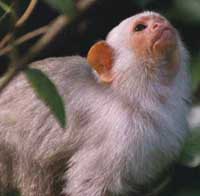This family, containing 5 genera and 26 species, is found only in the tropical forests of Central and South America. It includes the marmosets and tamarins.
Callitrichidae
marmosets, tamarins
Marmosets and tamarins are among the smallest primates, with head and body lengths as small as 130 mm and tails of 150 mm. Adults of the pygmy marmoset weigh a mere 100 grams! The face is very sparsely furred or naked. The pelage is soft and silky, and often includes characteristic tufts of hair on the head. Coloration is variable and in some cases quite striking to the human eye. Unlike many other New World primates, marmosets do not have a prehensile tail.
In form, callitrichids resemble other primates that cling vertically to trees. The forelimbs are shorter than the hind limbs, but most locomotion is quadrupedal. The hands and feet resemble those of squirrels. The thumb and big toe are not opposable. The surfaces of the hands and feet are long relative to the digits. Additionally, all of the digits except the hallux have sharp claws, not the flattened nails found in many other primates. Callitrichids use these claws to dig into the bark of trees.
Marmosets generally have triangular upper molars, and they lack the third molar found in cebids. Their dental formula is 2/2, 1/1, 3/3, 2/2 = 32. Otherwise, the skull of callitrichids resembles that of a small cebid or cercopithecid, with a large braincase, short rostrum, and large, forward-directed orbits.
Callitrichids are diurnal and live in family groups. The general pattern of association between males and females is monogamy or polyandry, a mating system where one female has more than one mate. Females produce one to three young annually. Young are often carried on the parents' backs. In species where twins are produced, the male often carries the young while the mother forages, transferring them back to their mother only long enough for the offspring to nurse. In the saddle-backed tamarin, a species where polyandry occurs, a female associates with two males only temporarily. When the young from the first litter mature and are able to help carry their siblings, the "extra" adult male is expelled from the social group.
Like most small primates, members of this family are primarily insectivorous, although small birds, fruits and seeds, and even gum or sap may be eaten at times.
HOME
Primates
Primate FAQ
Primate Species
Tamarin Pictures
Marmoset Pictures
Search Primates.com
Primates E-Mail Service
